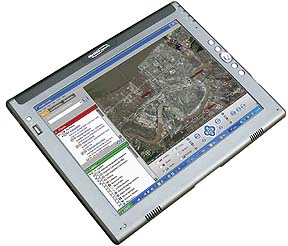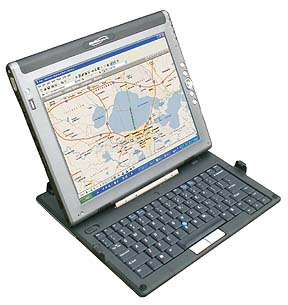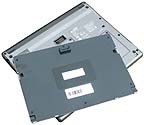

Current Cover
|
|
|
|
|
|
PenLab: Motion Computing LE1600Motion Computing makes a better, slimmer, faster pen slate--again (Pen Issue #56) When back in 2001 a small group of Dell executives decided to leave their lucrative employment in order to start Motion Computing, a company dedicated to building pen slates, most industry insider thought those guys had gone a bit loco. Despite Microsoft's renewed interest in some sort of Tablet PC, pen slates weren't exactly high on the list of promising fields to get involved in. And didn't it occur to those guys that Fujitsu practically owned whatever pen slate market there was anyway? Haha.
When back in 2001 a small group of Dell executives decided to leave their lucrative employment in order to start Motion Computing, a company dedicated to building pen slates, most industry insider thought those guys had gone a bit loco. Despite Microsoft's renewed interest in some sort of Tablet PC, pen slates weren't exactly high on the list of promising fields to get involved in. And didn't it occur to those guys that Fujitsu practically owned whatever pen slate market there was anyway? Haha.
It's four years later and no one is laughing anymore. Motion Computing turned out to be a supremely competent company with a singleminded focus on making the best pen slates possible. Sure they had to take on Fujitsu at its own game, and they did so with amazing skill and success. By 2004, Fujitsu and Motion were running neck on neck on the worldwide market for pen slates. Not bad at all. How did Motion manage to succeed so quickly and so impressively? By identifying a market niche--pen slates--and then unerringly pursuing that niche. Motion never let itself get sidetracked into spreading itself too thin with different products and form factors. By being extremely nimble on their feet in a market where technological progress traditionally trailed consumer market products by several years. Motion customers are always the first to get the latest technology. By complementing their technological prowess with a level of marketing savvy rarely seen in a vertical market newcomer.
Enter the LE1600 which Motion introduced earlier this year. Following the excellent and award-winning M1200, M1300, and M1400 slates was no easy task as those machines were already about as good as it gets. Our first exposure to the LE1600 came during a dinner with Motion executives in San Francisco. They handed us first the "old" M1400, then the new LE1600. While the two models look quite similar, there is a significant difference in the way they feel. Despite its durability and competent design, the M-Series had always felt just a little bit loose. Some details didn't feel quite as tight as they should have, and the tablet gave and creaked a bit when you twisted it. Slimmer, lighter, stronger, fasterThe Motion LE1600 changes all that. It is slimmer, lighter, and yet stronger than the older M-Series design. Take it in your hands and it really does feel like a slate, with most of the machine barely more than half an inch thick. There are PDAs and Pocket PCs thicker than the LE1600. It also feels extremely sturdy and solid. That's thanks to a novel construction that utilizes magnesium alloy for the lover bezel and a carbon fiber blend for the upper half. Yes, that's carbon fiber--lightweight and strong as few other materials. As a result, despite its thinness, the LE1600 truly feels as solid as the proverbial rock. If you didn't know it is assembled from a variety of high-tech materials, you'd swear it was milled from a solid block of some expensive space-age metal.
While pen slates, and especially pen slates as thin as this one, usually don't have a lot of onboard connectivity, the LE1600 has plenty. There are two USB 2.0 jacks, audio in and out, infrared, an RJ-45 connector for the unit's gigabit Ethernet, VGA and a DVI-D digital video output, a docking connector, a special Motion accessory port, and power. For expansion there is a full PC Card Type II slot plus a SD slot sitting on top of it. And with security becoming an ever greater concern, especially in corporate environments, the LE1600 also comes standard with an integrated fingerprint reader. For wireless, you get integrated Bluetooth plus either Intel's built-in 802.11b/g or optionally an Atheros 802.11a/b/g card.
Specifications, however, only describe part of the beauty of this machine. The other part is all the terrific functionality Motion baked into this design. Speech recognition and audio recordings, for example, work better than in almost any other machine thanks to Motion's ingenious "Speak Anywhere" technology that intelligently switches between two of the three microphones, and there is superb noise suppression and echo cancellation. For security the Trusted Platform Module (TPM) offers hardware-based encryption and authentication. The BIOS is tamper-proof. A "Security Center" provides quick access to everything. Buttons and controls are tighter and better placed than before. The Motion "dashboard" allows access to all key functions on one screen. The new snap-on keyboard works quite well and offers convertible-like convenience.
With the LE1600--a 2005 Pen Computing Magazine Editor's Choice Award winner--Motion Computing hit another one clean out of the ballpark. The competition should be concerned, very concerned. - www.motioncomputing.com |
 And finally by not falling into the trap of trying to be all things to all people. Motion primarily targets certain markets in healthcare, field sales and government. As a result, they can concentrate on designing and building their machines for the exact demands of those markets rather than having to offer numerous different versions. For example, Motion early on decided that while their slates needed to be durable, there was no need to build them like tanks. Once that decision was made, engineers and designers were free to build the best durable slates possible. The decision also made it unnecessary to change design directions with every new model.
And finally by not falling into the trap of trying to be all things to all people. Motion primarily targets certain markets in healthcare, field sales and government. As a result, they can concentrate on designing and building their machines for the exact demands of those markets rather than having to offer numerous different versions. For example, Motion early on decided that while their slates needed to be durable, there was no need to build them like tanks. Once that decision was made, engineers and designers were free to build the best durable slates possible. The decision also made it unnecessary to change design directions with every new model.
 However, as is always the case with Motion's machines, the beauty is not only skin-deep. The boys and girls in Austin also made sure that their latest and greatest was technologically up-to-date, and then some. Power comes either from a 1.5GHz low voltage Intel Pentium M 758 processor or--for when every watt-hour counts-- an ultra low voltage 1.0GHz Celeron M 373. System RAM uses 400MHz DDR2 chips. The Pentium model comes with 512MB standard and can be upgraded to 1.5GB. The Celeron model starts at 256MB and can be upgraded to 1.25GB. An Intel 915GMS chipset with a maximum of 128MB handles graphics.
However, as is always the case with Motion's machines, the beauty is not only skin-deep. The boys and girls in Austin also made sure that their latest and greatest was technologically up-to-date, and then some. Power comes either from a 1.5GHz low voltage Intel Pentium M 758 processor or--for when every watt-hour counts-- an ultra low voltage 1.0GHz Celeron M 373. System RAM uses 400MHz DDR2 chips. The Pentium model comes with 512MB standard and can be upgraded to 1.5GB. The Celeron model starts at 256MB and can be upgraded to 1.25GB. An Intel 915GMS chipset with a maximum of 128MB handles graphics.
 On the display side, there was little room for improvement. The LE1600 has the superb 12.1-inch Hydis screen with both vertical and horizontal viewing angles approaching 180 degrees. There is nothing like it. As good as the Hydis is, it is still a transmissive design, and so Motion offers an optional "View Anywhere" screen that puts a good degree of outdoor viewability on top of the Hydis display.
On the display side, there was little room for improvement. The LE1600 has the superb 12.1-inch Hydis screen with both vertical and horizontal viewing angles approaching 180 degrees. There is nothing like it. As good as the Hydis is, it is still a transmissive design, and so Motion offers an optional "View Anywhere" screen that puts a good degree of outdoor viewability on top of the Hydis display.
 How big is the LE1600? It has a footprint of 11.65 x 9.45 inches and is between 0.7 and 0.87 inches thick. In fact, it's only a 1.5 inch strip along the top end of the device that is thicker. That's because of the standard 35 watt-hour Lithium-Ion battery. Now for another welcome surprise: if you need more battery power, Motion offers an ultra-thin 7 x 10.5 Lithium-Polymer battery that neatly snaps onto the back of the device, the thin part of it. So now you have a total of 75 watt-hour of battery power in a device that is still not even 0.9 inches thick. Weight with the standard battery is just 3.1 pounds. The Li-Polymer pack adds another pound.
How big is the LE1600? It has a footprint of 11.65 x 9.45 inches and is between 0.7 and 0.87 inches thick. In fact, it's only a 1.5 inch strip along the top end of the device that is thicker. That's because of the standard 35 watt-hour Lithium-Ion battery. Now for another welcome surprise: if you need more battery power, Motion offers an ultra-thin 7 x 10.5 Lithium-Polymer battery that neatly snaps onto the back of the device, the thin part of it. So now you have a total of 75 watt-hour of battery power in a device that is still not even 0.9 inches thick. Weight with the standard battery is just 3.1 pounds. The Li-Polymer pack adds another pound.